Unfiltered
Tik-Tok and the emerging face of culture
New Media / Net based Installation
![Kunstraum Walcheturm, Zurich]()
![Space 10, New Delhi]()
![Reithalle, St. Moritz]()
![ICA, Yerevan]()
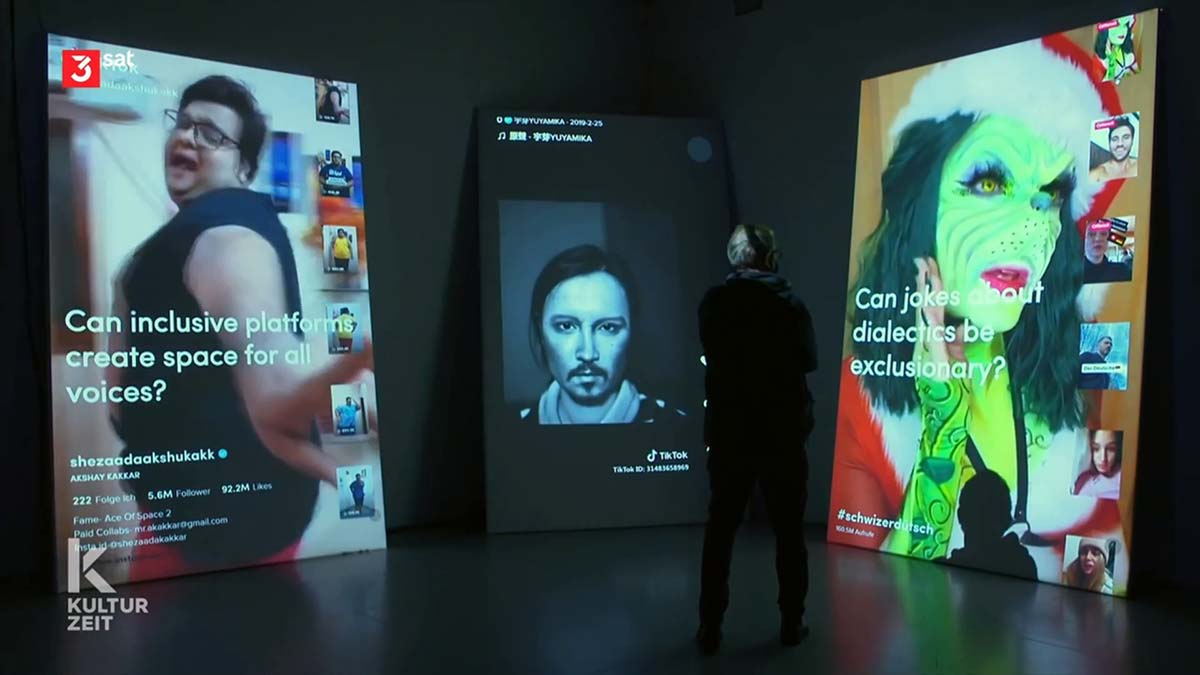



Unfiltered is an immersive net-based installation on digital accessibility, questioning its impact on public consciousness, visual aesthetics, and identity structures. It speculates on the role of technology and social platforms as tools of mass influence and positive social change.
With unprecedented and ever-increasing access to smartphones and the internet, digital hierarchies are being broken. Platforms like TikTok are the new town halls with 'influence' no longer restricted to the urban elite. In a country like India where class barriers have propagated exclusive silos of physical and digital spaces, a platform like TikTok has broken those boundaries, levelling the playing field. This has in turn enabled a new generation of content creators who exist outside urban echo chambers and has led to the creation of unique visual languages.
But what have the voices missing from mainstream been saying? Can positive social messaging lead to systemic change? Can complex ideas around gender, sexuality, identity, and social equity be understood and adopted through such platforms? Unfiltered poses these questions and more through the diverse voices of TikTok.
Unfiltered was made in collaboration with Swiss New Media artist Marc Lee. The net-based installation is localized for each country to reflect the voices and ideas being projected by the youth. The Project was Supported by The India Art Fair and Pro Helvetia New Delhi, St+art India Foundation, and SPACE10 [IDEO]
With unprecedented and ever-increasing access to smartphones and the internet, digital hierarchies are being broken. Platforms like TikTok are the new town halls with 'influence' no longer restricted to the urban elite. In a country like India where class barriers have propagated exclusive silos of physical and digital spaces, a platform like TikTok has broken those boundaries, levelling the playing field. This has in turn enabled a new generation of content creators who exist outside urban echo chambers and has led to the creation of unique visual languages.
But what have the voices missing from mainstream been saying? Can positive social messaging lead to systemic change? Can complex ideas around gender, sexuality, identity, and social equity be understood and adopted through such platforms? Unfiltered poses these questions and more through the diverse voices of TikTok.
Unfiltered was made in collaboration with Swiss New Media artist Marc Lee. The net-based installation is localized for each country to reflect the voices and ideas being projected by the youth. The Project was Supported by The India Art Fair and Pro Helvetia New Delhi, St+art India Foundation, and SPACE10 [IDEO]
India Unfiltered: 3 Channel installation, New Delhi
Unfiltered is a 3-channel installation that creates an endless flow of rich videos and media reflecting the voices of youth. The premise of the installation came from a speculation that in a country like India, which now has the world's largest young population - a majority of which engages with such apps - can mass exposure to positive social messaging lead to systemic change?
![]() The Left Channel is an aggregation of hashtags representing positive social change messages. For example: #stoprape, #helppoor, #stopacidattacks, #cleanindia, #stopbullying, #genderfluidity, and so on. The screen runs each hashtag for 2-5 minutes, showcasing its top videos. Each hashtag also has a question posed as a speculation on top of the video stream. On average, the total view count of these hashtags ranges from a few million to 2.5 billion.
The Left Channel is an aggregation of hashtags representing positive social change messages. For example: #stoprape, #helppoor, #stopacidattacks, #cleanindia, #stopbullying, #genderfluidity, and so on. The screen runs each hashtag for 2-5 minutes, showcasing its top videos. Each hashtag also has a question posed as a speculation on top of the video stream. On average, the total view count of these hashtags ranges from a few million to 2.5 billion.
![]() The Center Channel showcases a curated selection representing unique mashups of aesthetics, innovative use of technology and the most viewed/top trending videos within the geography to give a snapshot of the region's sensibilities.
The Center Channel showcases a curated selection representing unique mashups of aesthetics, innovative use of technology and the most viewed/top trending videos within the geography to give a snapshot of the region's sensibilities.
![]() The Right Channel is a curated selection of users that create niche content that challenges societal norms. Often these users belong to or represent marginalised or fringe communities. Some themes are LGBTQI representation, innovative approaches to education, bodypositivity, anti ablesim etc.
The Right Channel is a curated selection of users that create niche content that challenges societal norms. Often these users belong to or represent marginalised or fringe communities. Some themes are LGBTQI representation, innovative approaches to education, bodypositivity, anti ablesim etc.
 The Left Channel is an aggregation of hashtags representing positive social change messages. For example: #stoprape, #helppoor, #stopacidattacks, #cleanindia, #stopbullying, #genderfluidity, and so on. The screen runs each hashtag for 2-5 minutes, showcasing its top videos. Each hashtag also has a question posed as a speculation on top of the video stream. On average, the total view count of these hashtags ranges from a few million to 2.5 billion.
The Left Channel is an aggregation of hashtags representing positive social change messages. For example: #stoprape, #helppoor, #stopacidattacks, #cleanindia, #stopbullying, #genderfluidity, and so on. The screen runs each hashtag for 2-5 minutes, showcasing its top videos. Each hashtag also has a question posed as a speculation on top of the video stream. On average, the total view count of these hashtags ranges from a few million to 2.5 billion. The Center Channel showcases a curated selection representing unique mashups of aesthetics, innovative use of technology and the most viewed/top trending videos within the geography to give a snapshot of the region's sensibilities.
The Center Channel showcases a curated selection representing unique mashups of aesthetics, innovative use of technology and the most viewed/top trending videos within the geography to give a snapshot of the region's sensibilities. The Right Channel is a curated selection of users that create niche content that challenges societal norms. Often these users belong to or represent marginalised or fringe communities. Some themes are LGBTQI representation, innovative approaches to education, bodypositivity, anti ablesim etc.
The Right Channel is a curated selection of users that create niche content that challenges societal norms. Often these users belong to or represent marginalised or fringe communities. Some themes are LGBTQI representation, innovative approaches to education, bodypositivity, anti ablesim etc.


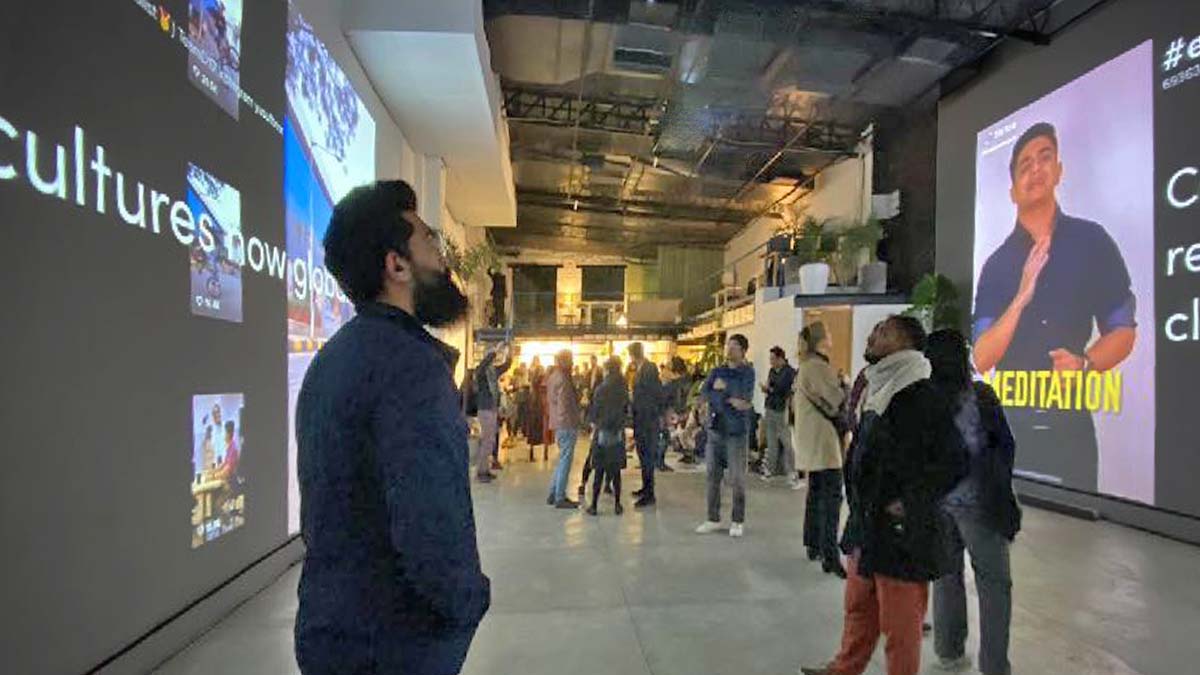

India Unfiltered, New Delhi
Swiss Unfiltered, Zurich

Swiss Unfiltered, Kunstraum Walcheturm, Zurich

Swiss Unfiltered, Reithalle, St. Moritz
EXHIBITIONS:
- CYFEST-15 International Media Art Festival, Institute for Contemporary Art, Yerevan, Armenia
- Arab Media Lab, Marrakesh, Morocco
- Hacking Identity - Dancing Diversity, European Capitals of Culture, Möllerei Esch,
Luxembourg - Swiss Media Art - Pax Art Awards, HEK (House of Electronic Arts), Basel, Switzerland
- Infrastrukturen, Galerie für Gegenwartskunst E-Werk, Freiburg, Germany
- Swiss Unfiltered, My home is my castle, Forum Schlossplatz, Aarau, Switzerland
- Swiss Unfiltered Da Z Digital Culture Festival, Kunstraum Walcheturm and Museum für Gestaltung, Zurich, Switzerland
- Games.Fights.Encounters, ONCURATING Project Space, Zurich, Switzerland
- India Unfiltered, Palladium, Chennai, India
- India Unfiltered, SPACE10, New Delhi, India
Hanging in the Void
Installation / Augmented Reality
Space - the final frontier.
An untouched, endless landscape made of interstellar stardust.
Or so you thought.
Hanging in the void is a multimedia installation comprising an Augmented Reality experience, a Zine, and a 1-channel video that visualizes the growing issue of space debris. Humans have launched over 8,000 objects into space since 1957. Currently, 5,000 objects orbit the Earth, less than 2,000 of which are functional. The rest is debris - floating around the Earth like flies around a giant garbage dump.
Most 'space junk' is moving very fast and can reach speeds of 18,000 miles per hour, almost seven times faster than a bullet. Due to the rate of speed and volume of debris in LEO (Low Earth Orbit), current and future space-based services, explorations, and operations pose a safety risk to people and property in space and on Earth.
Some statistics:
Here’s an interesting article about the issue
An untouched, endless landscape made of interstellar stardust.
Or so you thought.
Hanging in the void is a multimedia installation comprising an Augmented Reality experience, a Zine, and a 1-channel video that visualizes the growing issue of space debris. Humans have launched over 8,000 objects into space since 1957. Currently, 5,000 objects orbit the Earth, less than 2,000 of which are functional. The rest is debris - floating around the Earth like flies around a giant garbage dump.
Most 'space junk' is moving very fast and can reach speeds of 18,000 miles per hour, almost seven times faster than a bullet. Due to the rate of speed and volume of debris in LEO (Low Earth Orbit), current and future space-based services, explorations, and operations pose a safety risk to people and property in space and on Earth.
Some statistics:
- 34,000 pieces of space junk larger than 10 centimeters
- 128 million pieces of space junk larger than 1 millimeter
- One in 10,000: risk of collision that will require debris avoidance maneuvers
Here’s an interesting article about the issue
You enter a room and find the walls inscribed with names of all satellites launched into space since 1957. One of the walls has a large image of the Earth - ‘The Blue Marble’ taken from space on December 7, 1972, and is one of the most reproduced images in history. It was taken by the crew of the Apollo 17 spacecraft on its way to the Moon.
The image triggers an AR experience that shows the amount of space debris around the Earth. The scale of the debris is ofcourse exaggerated relative to the Earth, the size of the debris would be much smaller. But it gives a sense of the amout of particulate matter orbitting the Earth.
The research for this installation was sourced through public databases provided by the United Nations Office for Outer Space Affairs and the Union of Concerned Scientists, which list all 8,378 objects launched since 1957, and 4,987 objects currently whizzing above our heads at this very moment in time. Data was last updated in January 2019.

The Zine consists of stills from iconic sci-fi movies that have visualized the Earth from space. Our impressions of the world around us are built by the media we consume, with images in pop culture and films creating an impression that is most times, an illusion. Films like 2001: A Space Odyssey, Alien, Event Horizon, and Interstellar all build this pristine image of space as an untouched final frontier, which is far from reality.
Hanging in the Void has been exhibited at F(r)iction at Kona, New Delhi in 2019.
Hanging in the Void has been exhibited at F(r)iction at Kona, New Delhi in 2019.
Inside Out x Sassoon Dock
Public Art, Installation, Photo
Sassoon Dock is a 145-year-old fishing dock in South Mumbai. The fishermen and women communities of Sassoon are among the oldest settlers of Bombay, being the invisible lifeline that helped the city build around them. The Inside Out Project at Sassoon Dock aimed to shed light on the faces behind Sassoon as a way of celebrating their lives, livelihoods, and contribution to the city.
In the city of Bollywood, where celebrities and film stars are eulogized on large-size posters, the representation of the everyday workers of Sassoon was a way of acknowledging their immense value in the very space they inhabit daily. The project celebrated them as the real stars of the city of stars. This was done by pasting large portraits of the people of Sassoon Docks on the very warehouses they work in.
The Inside Out Project is a global art project transforming messages of personal identity into works of art. The project was initiated by French artist-photographer extraordinaire JR. Find out more here
This project was done in collaboration with photographer Pranav Gohil
RESEARCH
In the city of Bollywood, where celebrities and film stars are eulogized on large-size posters, the representation of the everyday workers of Sassoon was a way of acknowledging their immense value in the very space they inhabit daily. The project celebrated them as the real stars of the city of stars. This was done by pasting large portraits of the people of Sassoon Docks on the very warehouses they work in.
The Inside Out Project is a global art project transforming messages of personal identity into works of art. The project was initiated by French artist-photographer extraordinaire JR. Find out more here
This project was done in collaboration with photographer Pranav Gohil
RESEARCH

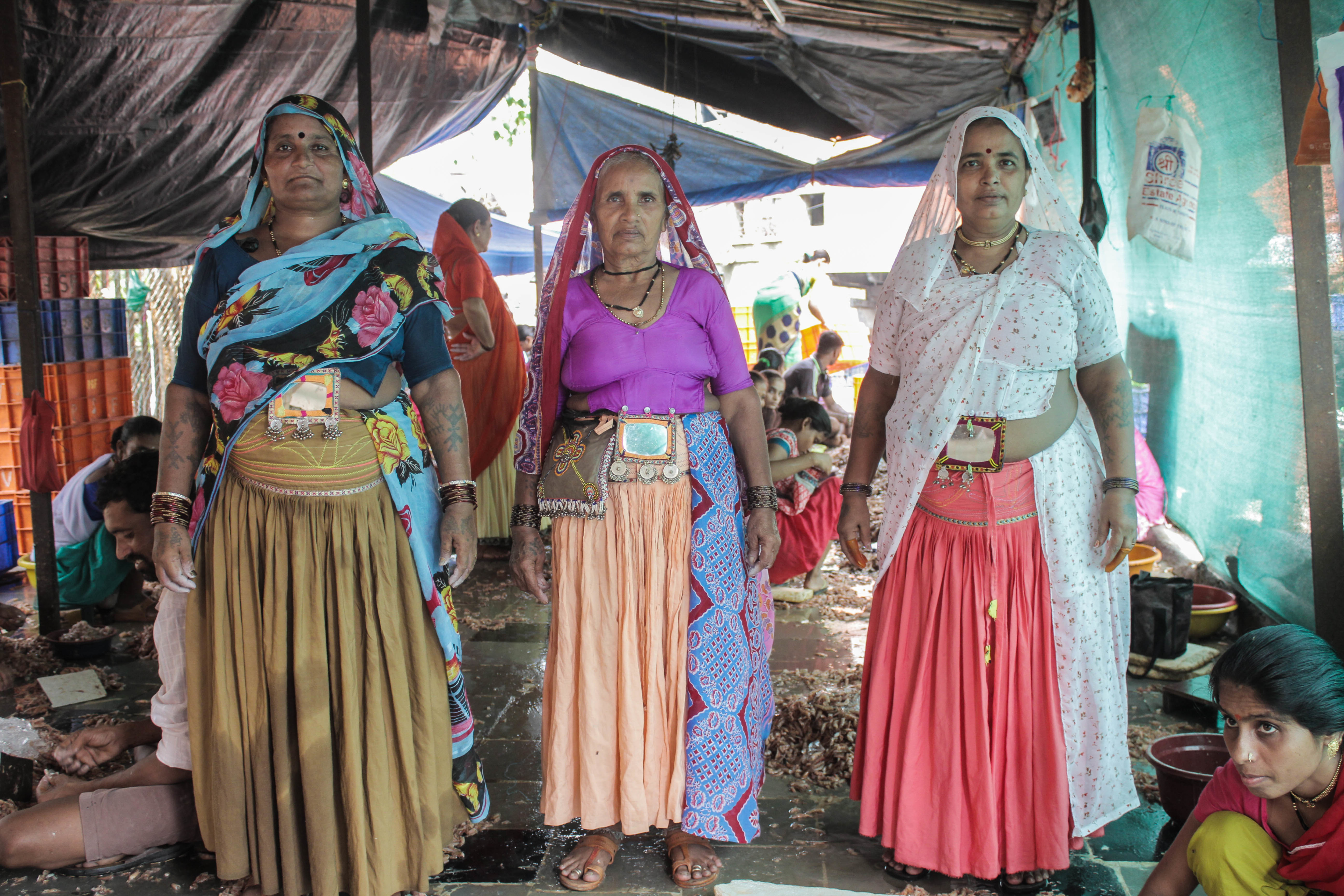

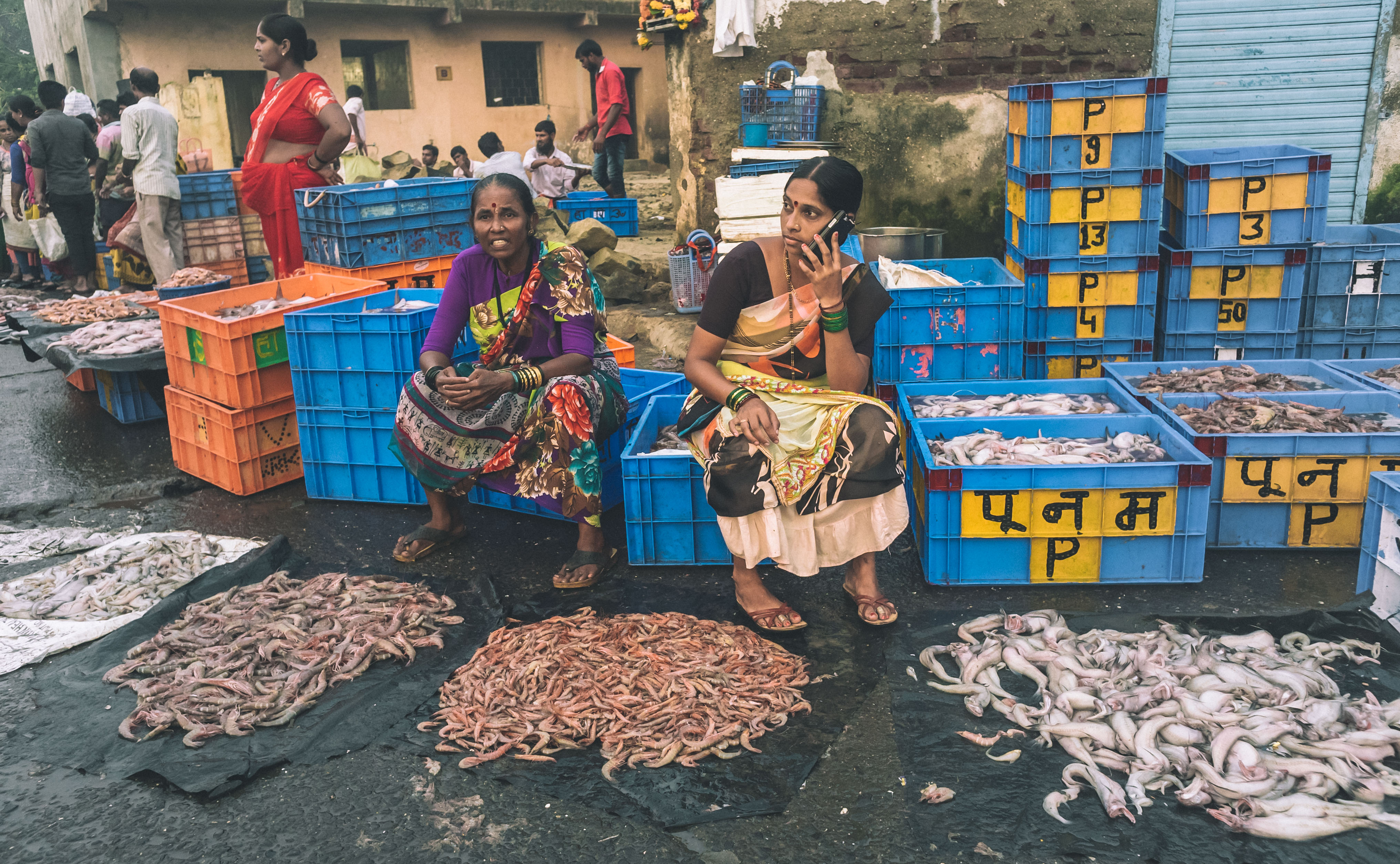


The Sassoon Dock is situated in Colaba, in the heart of the old town. Yet it is a space most locals are unaware of. The initial research entailed spending days at the dock to get a sense of the dynamics of the space, while speaking with community leaders helped understand the different socio-cultural demographics of the communities living and working in the area.
Having been misrepresented by several journalists, photographers, and foreigners over the years, we were initially met with hesitation. But over weeks of clearing their doubts and making them understand the intent of the project, we were able to gain the trust of the community leaders.
Through the conversations, it emerged that Sassoon Dock was primarily inhabited by three communities - The Koli Fishermen, The Banjaras, and The Hindu Marathas. All three communities were integral to the micro-economy of the market.
The Koli Fishermen go out to sea and catch the fish, while the women help to sell them. The Banjara men handle hauling the fish off the boats, while the women help in the peeling activities. The Hindu Marathas are the carters - both men and women. They transport fish from the wholesalers to smaller sellers within Sassoon and other parts of the city.
PRODUCTION
To build the project without causing too much disruption to their lives, a temporary studio was set up within an abandoned part of the warehouse to make portraits of the community. Eventually, over 350 portraits were pasted across the walls of Sassoon Dock.

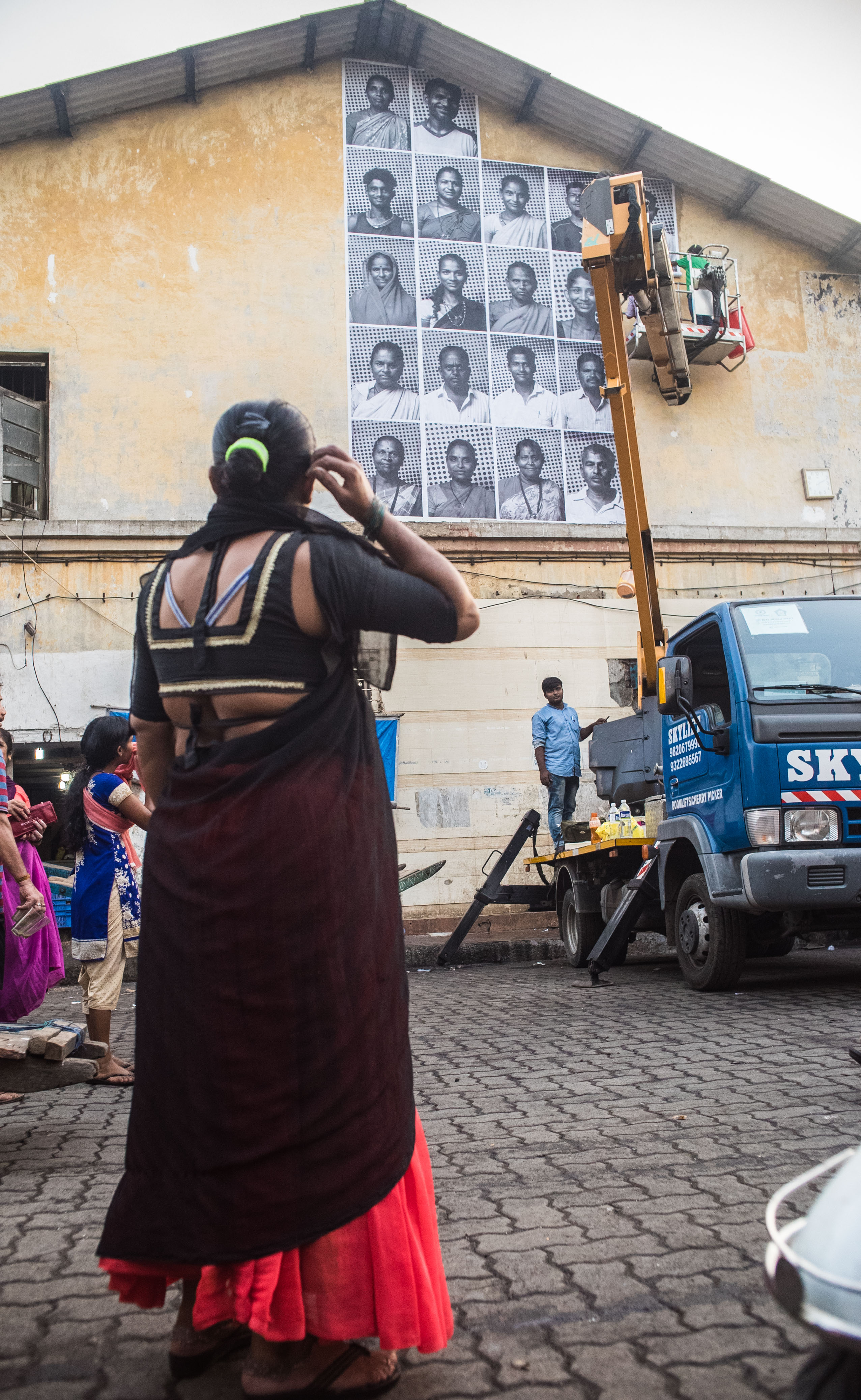
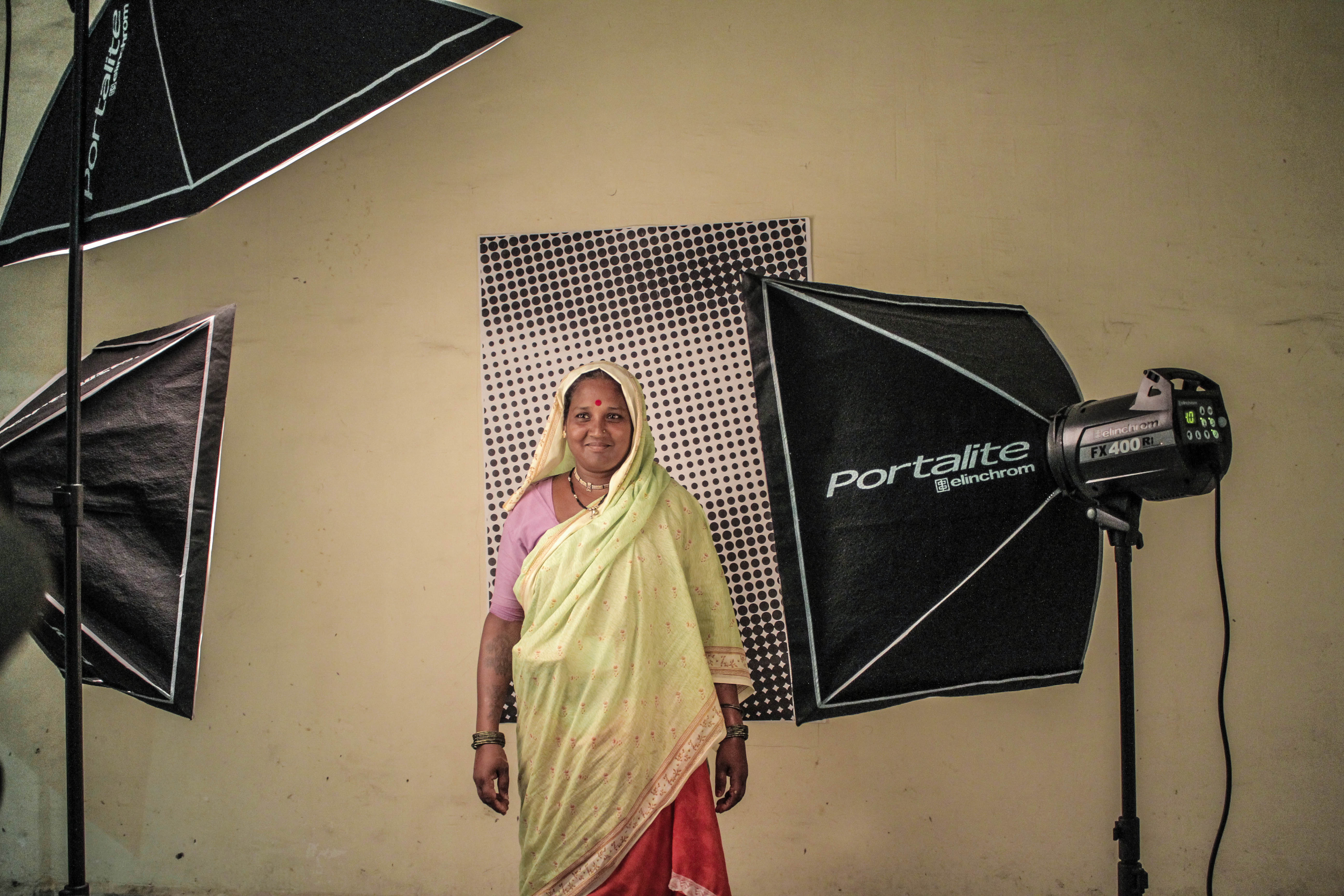
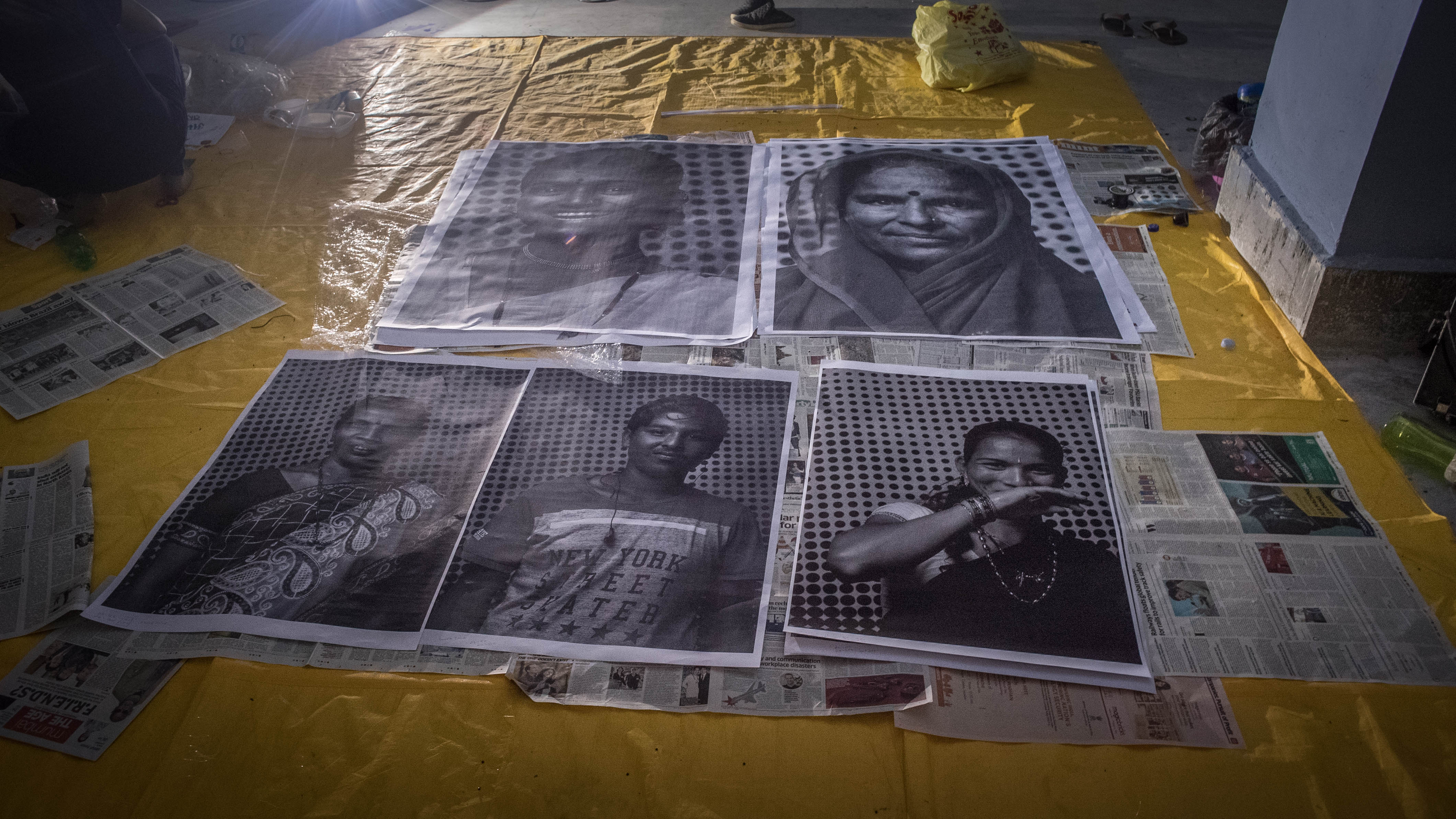
FINAL INSTALLATION


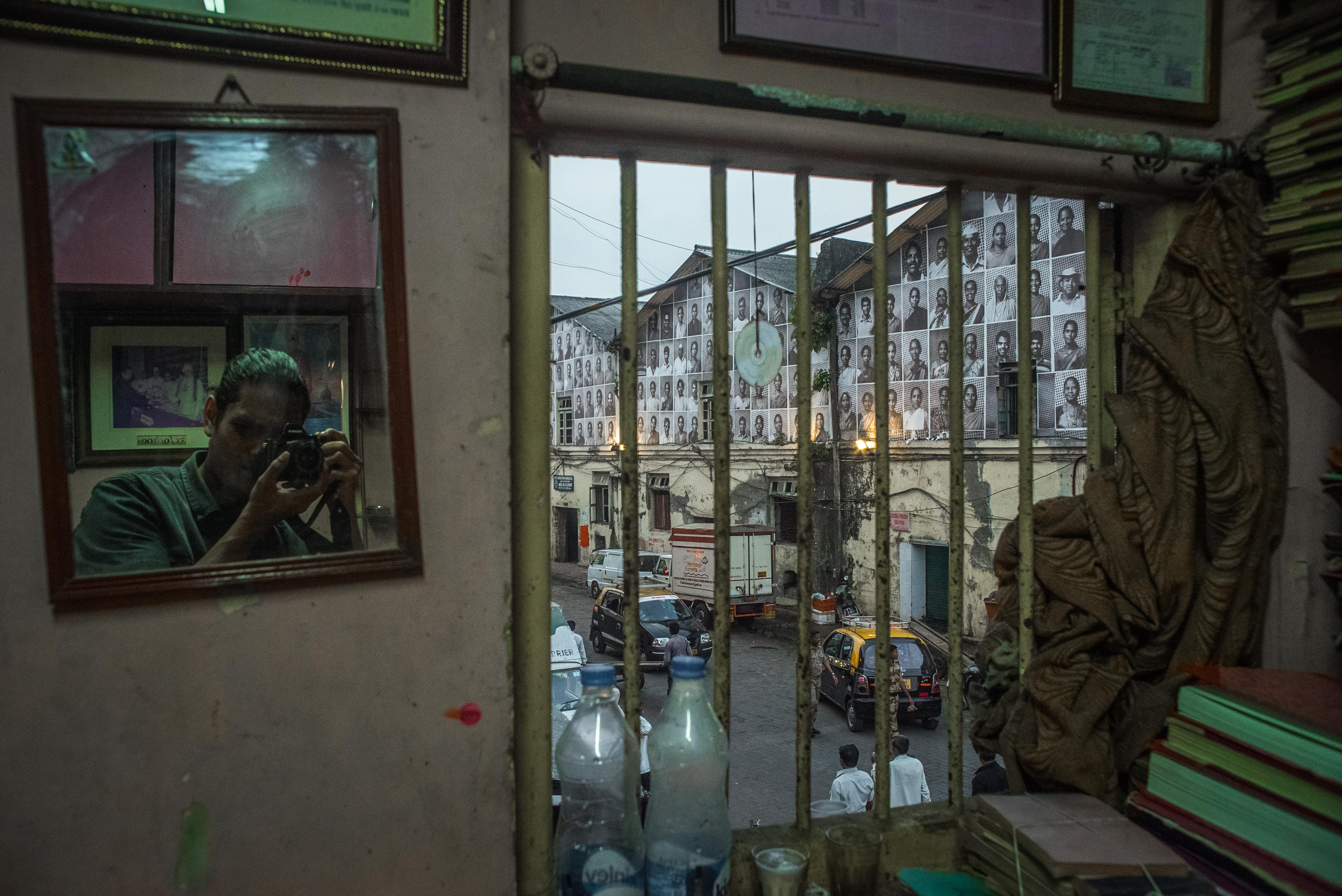
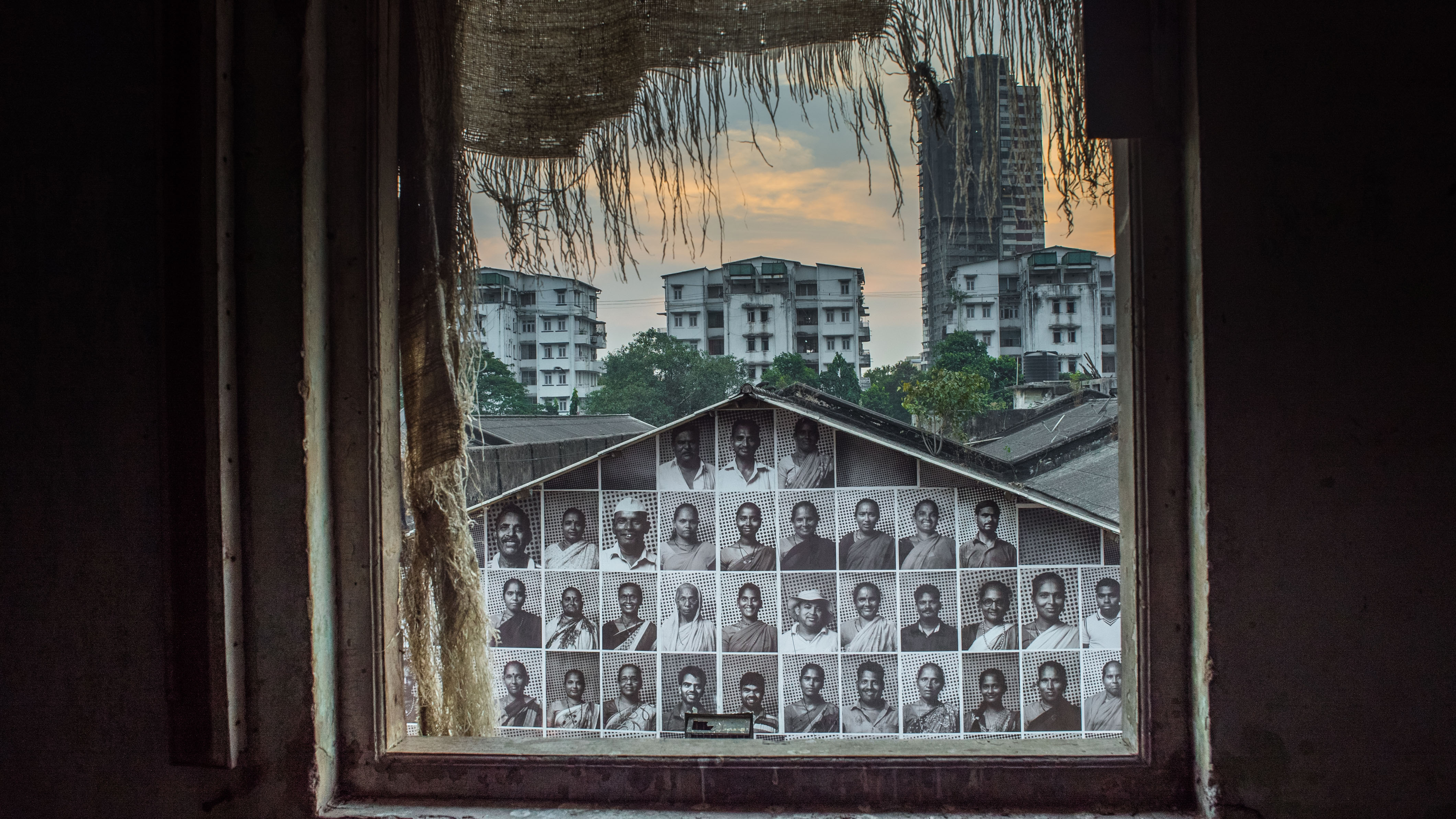
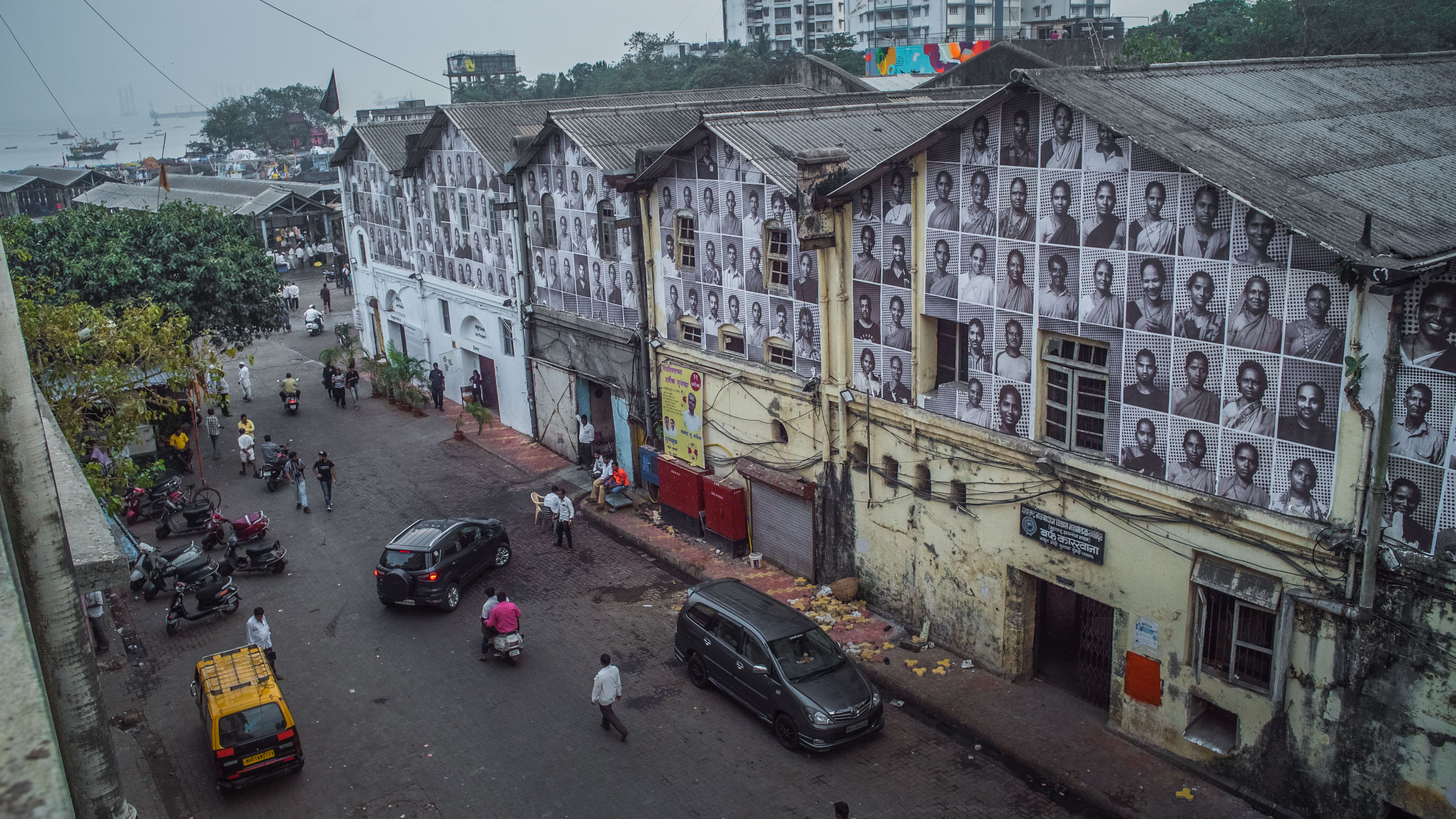

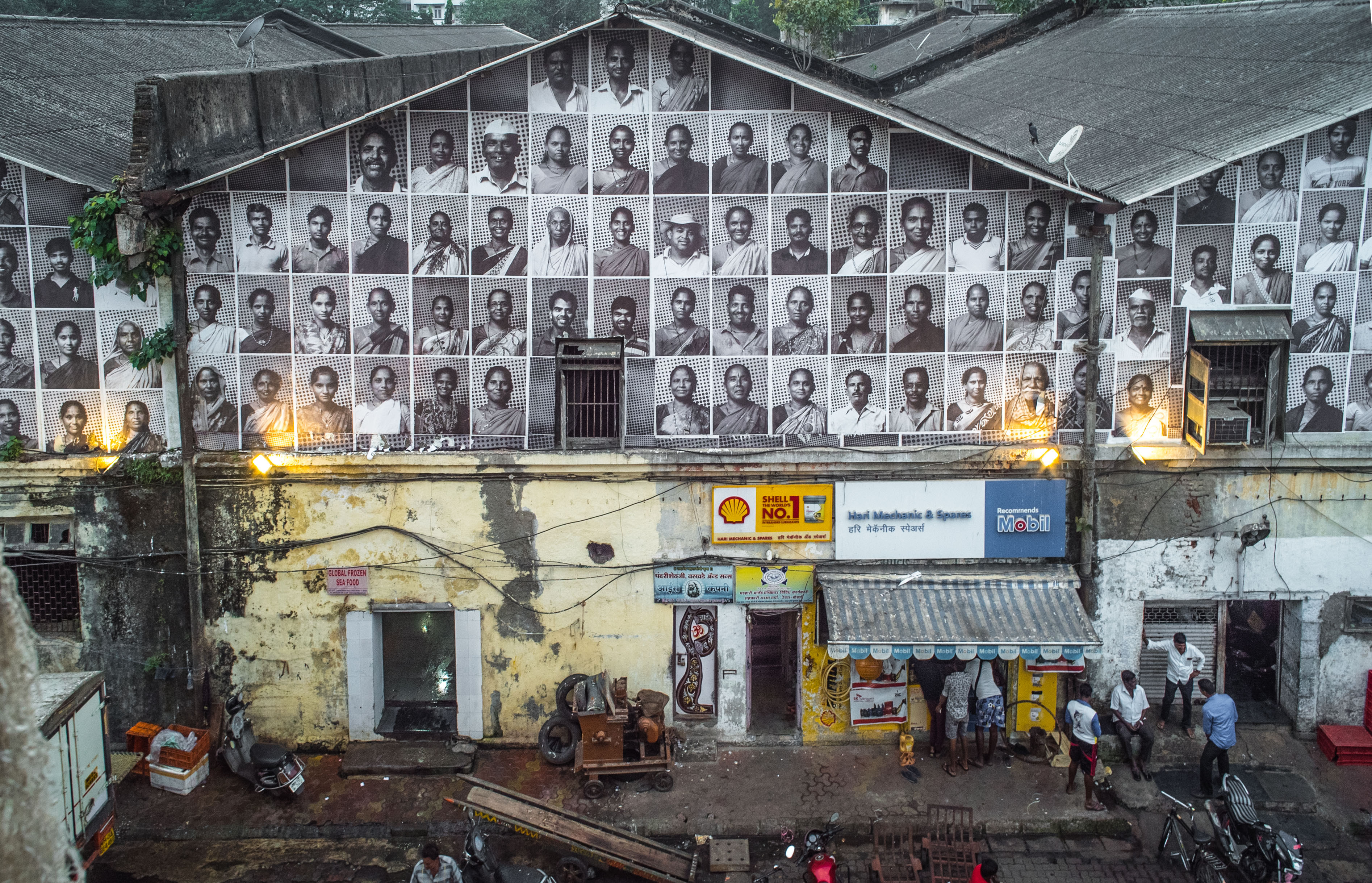
Here’s short film about the project
Unearthed
Public Art Mural / Web-VR
The Microverse
The Microverse
We humans are a conduit to infinity - both by being in an ever-expanding universe and simultaneously creating infinite virtual worlds within it.
And within that infinity, we are all minute fractional microorganisms, pulsating at our own unique frequencies, creating (and destroying) ecosystems and society.
The Microverse represents one such virtual world. Each entity within it emits a sound that builds a musical soundscape as you float through the experience.
In a time when the colonization of virtual spaces and the Metaverse is well and truly underway by corporates and get-rich-quick cash-grab projects, The Microverse is my claim to a piece of digital land - a safe place of solace. A heterotopia, or a dream - a parallel world within a world.
The Microverse is a positional audio-based web VR experience created as part of the Unearthed Project.
And within that infinity, we are all minute fractional microorganisms, pulsating at our own unique frequencies, creating (and destroying) ecosystems and society.
The Microverse represents one such virtual world. Each entity within it emits a sound that builds a musical soundscape as you float through the experience.
In a time when the colonization of virtual spaces and the Metaverse is well and truly underway by corporates and get-rich-quick cash-grab projects, The Microverse is my claim to a piece of digital land - a safe place of solace. A heterotopia, or a dream - a parallel world within a world.
The Microverse is a positional audio-based web VR experience created as part of the Unearthed Project.
Unearthed Aftermovie
Inspired by the wild spaces that exist within and around us, PluginHUMAN, Yorta Yorta artist Lorraine Brigdale, and Akshat Nauriyal bring you UNEARTHED, a projection-mapped mural and a Web-VR 'Microverse'.
UNEARTHED engages both physical and digital landscapes. The artwork features a mural with contemporary re-workings of Yorta Yorta shields by Lorraine Brigdale and enlarged micrographs by Betty Sargeant. Embedded in the mural is an icon that connects audiences with a microverse. When audiences hold their phones to the icon, they access an explorable digital landscape created by Mumbai-based new media artist Akshat Nauriyal and PluginHUMAN. This microverse is a parallel universe that exists alongside our non-digital reality. At night, the mural is transformed into a projection-mapped light experience created by Justin Dwyer.
The name 'microverse' is used here to describe a small independent digital landscape. People don't need to download an app or log in. It's a web-based 3D digital experience. Many contemporary people exist in both an analogue universe that is ever-expanding and within virtual spaces built on digital topographies. This microverse is a digital space that draws on elements of the analogue world; it's a heterotopia or dreamspace.
UNEARTHED engages both physical and digital landscapes. The artwork features a mural with contemporary re-workings of Yorta Yorta shields by Lorraine Brigdale and enlarged micrographs by Betty Sargeant. Embedded in the mural is an icon that connects audiences with a microverse. When audiences hold their phones to the icon, they access an explorable digital landscape created by Mumbai-based new media artist Akshat Nauriyal and PluginHUMAN. This microverse is a parallel universe that exists alongside our non-digital reality. At night, the mural is transformed into a projection-mapped light experience created by Justin Dwyer.
The name 'microverse' is used here to describe a small independent digital landscape. People don't need to download an app or log in. It's a web-based 3D digital experience. Many contemporary people exist in both an analogue universe that is ever-expanding and within virtual spaces built on digital topographies. This microverse is a digital space that draws on elements of the analogue world; it's a heterotopia or dreamspace.

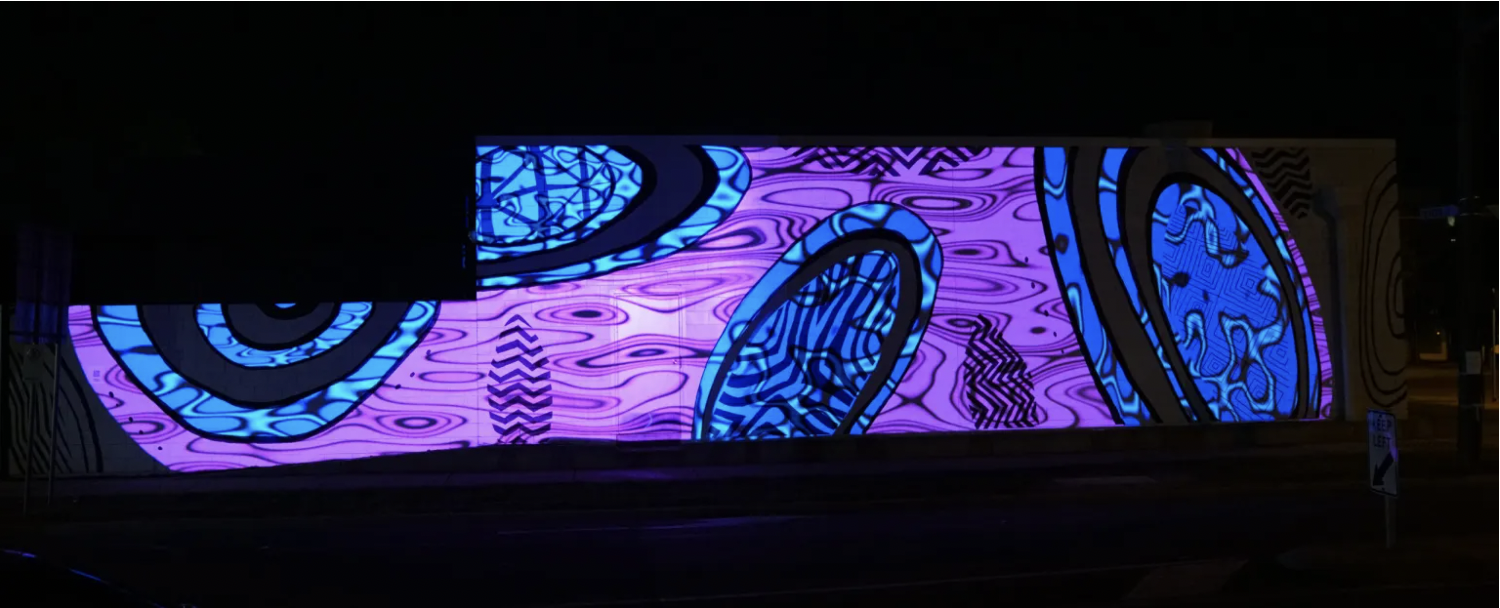


This project was supported by Asialink Arts, The Australian High Commission, Delhi India, Renew Australia, The Exertion Games Lab GOTAFE, DULUX Australia and La TRobe University (Shepparton)
Unearthed and the Microverse have been exhibited at the Shepparaton Festival and the Glen Eira City Council Gallery, Australia.
Unearthed and the Microverse have been exhibited at the Shepparaton Festival and the Glen Eira City Council Gallery, Australia.